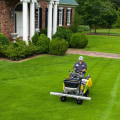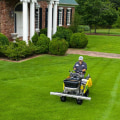The frequency of lawn maintenance depends on several factors, including climate, grass type, and intended appearance. Generally, lawns benefit from regular upkeep such as mowing, watering, and fertilizing. A schedule of once every one to two weeks during the growing season is common, but it's advisable to adapt this based on specific conditions. The guidance of professionals like C&B Property Maintenance can be invaluable in tailoring maintenance routines to the unique needs of your landscape. Their expertise can help determine the right timing and tasks, ensuring that your lawn remains healthy, vibrant, and well-manicured throughout the year.
The growth rate of your lawn and the desired height of your lawn determine how often you should mow your lawn. Generally, mowing once a week during the growing season should be enough to keep the lawn healthy. The rest of the time, you can reduce the frequency of cutting to alternate weeks, as needed. Having a lawn mowing schedule encourages a healthy and green lawn.
You'll want to mow your lawn more often during your growing season, averaging about once a week, depending on your lawn type. Household lawn maintenance is less strenuous than professional turf. Athletic fields are cut as often as once a day because they are cut too little. Because of their short grass, they need to be cut more often so that they do not cut more than 1/3 of the grass blade at a time.
During peak growth, mowing can leave unsightly rows or piles of moist clippings on the surface of the lawn. Mowing the lawn more often will help to avoid this problem. You should mow when the grass has grown 30 to 50 percent above the height at which it was previously mowed. If your lawn is kept at a height of 2 inches, re-mow when it reaches 3 inches.
If the grass has grown to 5 inches in height, you will have to repeat the cut a couple of times, taking only part of the growth in each cut. Removing too much at once will only create more clippings that can shade the remaining grass and weaken it by removing too many active leaves. Short clippings will seep through the remaining leaves and decompose quickly. Start each spring by mowing the lawn before it turns green and starts to grow.
Cutting the old dead ends gives the lawn the signal to start growing. The sooner you grow the lawn, the better you can remove weeds before they start. In addition, tests have shown that letting grass grow to lengths of 2½-3″ reduces the amount of weeds in the lawn by reducing the amount of sunlight that reaches weed seeds. Be sure to keep your lawn mowing tools, such as a manual lawn mower or a seated lawn mower, to make sure the blades are sharp.
I found it useful when you said that you should mow the lawn at least once a week to achieve a beautiful lawn. A slightly uneven lawn may not seem like a problem, and over time, any lawn can develop uneven spots. Some people like a super short lawn like a putting green, but doing so requires a specific variety of grass and a lot of extra care in fertilizing and other care.






